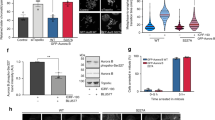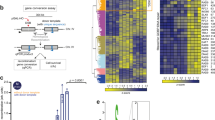Abstract
Mitotic kinases are the ultimate target of pathways sensing genotoxic damage and impinging on the cell cycle machinery. Here, we provide evidence that Aurora A (AurA) was inhibited upon generation of double-strand breaks in DNA. We demonstrate that AurA was not downstream of CDK1 and that inhibition of AurA and CDK1 by DNA damage occurred independently. Using a cell line functionally deficient in Chk2, a selective Chk1 inhibitor and siRNA to Chk1, we show that DNA-damage signals were delivered to AurA through a Chk1-dependent pathway. With regard to the molecular mechanism of AurA inhibition, we found that the point mutation Ser342>Ala rendered AurA resistant to inhibition by DNA damage. By means of two distinct approaches we examined the impact of reconstitution of AurA activity in DNA-damaged cells: (i) transient expression of wild-type and Ser342>Ala mutant, but not kinase-dead, AurA led to bypass of the DNA damage block; (ii) direct transduction of highly active wt-AurA into G2 arrested cells precisely after induction of DNA damage resulted in mitotic entry. We show that the mechanism through which AurA allowed entry into mitosis was reactivation of CDK1, thus indicating that AurA plays a key role upstream of CDK1. A model depicting the possible role of AurA at the onset of mitosis and upon DNA damage is presented.
This is a preview of subscription content, access via your institution
Access options
Subscribe to this journal
Receive 50 print issues and online access
$259.00 per year
only $5.18 per issue
Buy this article
- Purchase on Springer Link
- Instant access to full article PDF
Prices may be subject to local taxes which are calculated during checkout







Similar content being viewed by others
References
Andoh T, Ishida R . (1998). Biochim Biophys Acta 1400: 155–171.
Andresson T, Ruderman JV . (1998). EMBO J 17: 5627–5637.
Biggins S, Severin FF, Bhalla N, Sassoon I, Hyman AA, Murray AW . (1999). Genes Dev 13: 532–544.
Bischoff JR, Anderson L, Zhu Y, Mossie K, Ng L, Souza B et al. (1998). EMBO J 17: 3052–3065.
Castro A, Arlot-Bonnemains Y, Vigneron S, Labbe JC, Prigent C, Lorca T . (2002). EMBO Rep. 3: 457–462.
Chan CS, Botstein D . (1993). Genetics 135: 677–691.
Charrasse S, Carena I, Brondani V, Klempnauer KH, Ferrari S . (2000). Oncogene 19: 2986–2995.
Crawford DF, Piwnica-Worms H . (2001). J Biol Chem 276: 37166–37177.
Davies SP, Reddy H, Caivano M, Cohen P . (2000). Biochem J 351: 95–105.
De Azevedo WF, Leclerc S, Meijer L, Havlicek L, Strnad M, Kim SH . (1997). Eur J Biochem 243: 518–526.
Dutertre S, Cazales M, Quaranta M, Froment C, Trabut V, Dozier C et al. (2004). J. Cell Sci 117: 2523–2531.
Falck J, Lukas C, Protopopova M, Lukas J, Selivanova G, Bartek J . (2001). Oncogene 20: 5503–5510.
Ferrari S, Marin O, Pagano MA, Meggio F, Hess D, El-Shemerly M et al. (2005). Biochem J 390: 293–302.
Giet R, Prigent C . (1999). J Cell Sci 112 (Part 21): 3591–3601.
Glover DM, Leibowitz MH, McLean DA, Parry H . (1995). Cell 81: 95–105.
Haydon CE, Eyers PA, Aveline-Wolf LD, Resing KA, Maller JL, Ahn NG . (2003). Mol Cell Proteomics 2: 1055–1067.
Hirota T, Kunitoku N, Sasayama T, Marumoto T, Zhang D, Nitta M et al. (2003). Cell 114: 585–598.
Honda K, Mihara H, Kato Y, Yamaguchi A, Tanaka H, Yasuda H et al. (2000). Oncogene 19: 2812–2819.
Joliot A, Prochiantz A . (2004). Nat Cell Biol 6: 189–196.
Katayama H, Zhou H, Li Q, Tatsuka M, Sen S . (2001). J Biol Chem 276: 46219–46224.
Kimura K, Hirano M, Kobayashi R, Hirano T . (1998). Science 282: 487–490.
Lengauer C, Kinzler KW, Vogelstein B . (1998). Nature 396: 643–649.
Littlepage LE, Ruderman JV . (2002). Genes Dev 16: 2274–2285.
Littlepage LE, Wu H, Andresson T, Deanehan JK, Amundadottir LT, Ruderman JV . (2002). Proc Natl Acad Sci USA 99: 15440–15445.
Loeb LA, Loeb KR, Anderson JP . (2003). Proc Natl Acad Sci USA 100: 776–781.
Marumoto T, Hirota T, Morisaki T, Kunitoku N, Zhang D, Ichikawa Y et al. (2002). Genes Cells 7: 1173–1182.
Marumoto T, Honda S, Hara T, Nitta M, Hirota T, Kohmura E et al. (2003). J Biol Chem 278: 51786–51795.
Maton G, Thibier C, Castro A, Lorca T, Prigent C, Jessus C . (2003). J Biol Chem 278: 21439–21449.
Mayor T, Meraldi P, Stierhof YD, Nigg EA, Fry AM . (1999). FEBS Lett 452: 92–95.
Meraldi P, Honda R, Nigg EA . (2002). EMBO J 21: 483–492.
Morris MC, Depollier J, Mery J, Heitz F, Divita G . (2001). Nat Biotechnol 19: 1173–1176.
Nghiem P, Park PK, Kim Y, Vaziri C, Schreiber SL . (2001). Proc Natl Acad Sci USA 98: 9092–9097.
Nigg EA . (2001). Nat Rev Mol Cell Biol 2: 21–32.
Nyberg KA, Michelson RJ, Putnam CW, Weinert TA . (2002). Ann Rev Genet 36: 617–656.
Peters JM . (2002). Mol Cell 9: 931–943.
Rouse J, Jackson SP . (2002). Science 297: 547–551.
Sen S, Zhou H, White RA . (1997). Oncogene 14: 2195–2200.
Smits VA, Medema RH . (2001). Biochim Biophys Acta 1519: 1–12.
Stenoien DL, Sen S, Mancini MA, Brinkley BR . (2003). Cell Motil Cytoskeleton 55: 134–146.
Walter AO, Seghezzi W, Korver W, Sheung J, Lees E . (2000). Oncogene 19: 4906–4916.
Zhao B, Bower MJ, McDevitt PJ, Zhao H, Davis ST, Johanson KO et al. (2002). J Biol Chem 277: 46609–46615.
Zhou H, Kuang J, Zhong L, Kuo WL, Gray JW, Sahin A et al. (1998). Nat Genet 20: 189–193.
Acknowledgements
We thank F Forcellino for having made preliminary observations, J Jiricny, P Schaer and M El-Shemerly for critical reading of the manuscript and EA Nigg for helpful suggestions. We are also indebted to S Kleiner and Y Nagamine for help and suggestions in the siRNA experiments, JL Salisbury for centrin monoclonal antibody, A Kraemer and J Lukas for CHK1 monoclonal antibody and S Hausaman, Cancer Therapy Evaluation Program, NCI, NIH, Rockville, MD, USA, for supplying UCN-01. SF is supported by a grant of the Zurich Cancer League and CP is supported by the Ligue Nationale Contre le Cancer (équipe Labéllisée).
Author information
Authors and Affiliations
Corresponding author
Additional information
Supplementary Information accompanies the paper on the Oncogene website (http://www.nature.com/onc).
Rights and permissions
About this article
Cite this article
Krystyniak, A., Garcia-Echeverria, C., Prigent, C. et al. Inhibition of Aurora A in response to DNA damage. Oncogene 25, 338–348 (2006). https://doi.org/10.1038/sj.onc.1209056
Received:
Revised:
Accepted:
Published:
Issue Date:
DOI: https://doi.org/10.1038/sj.onc.1209056
Keywords
This article is cited by
-
Three-dimensional nuclear telomere architecture and differential expression of aurora kinase genes in chronic myeloid leukemia to measure cell transformation
BMC Cancer (2022)
-
Aurora kinase A regulates Survivin stability through targeting FBXL7 in gastric cancer drug resistance and prognosis
Oncogenesis (2017)
-
Inhibition of Polo-like kinase 1 during the DNA damage response is mediated through loss of Aurora A recruitment by Bora
Oncogene (2017)
-
Checkpoint kinase 1 is essential for normal B cell development and lymphomagenesis
Nature Communications (2017)
-
Deregulation of vital mitotic kinase–phosphatase signaling in hematopoietic stem/progenitor compartment leads to cellular catastrophe in experimental aplastic anemia
Molecular and Cellular Biochemistry (2016)



